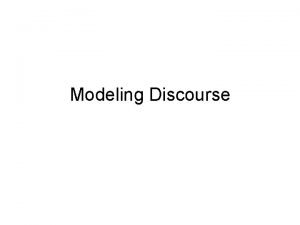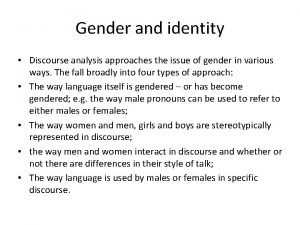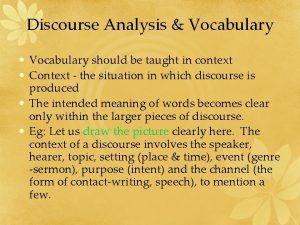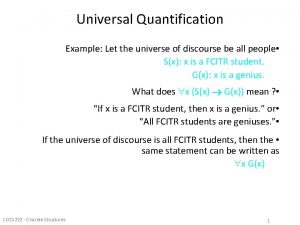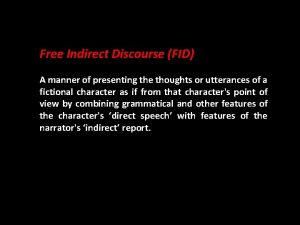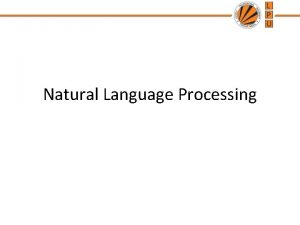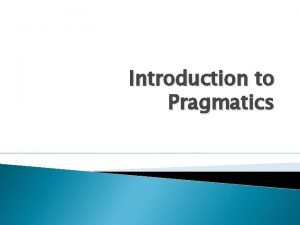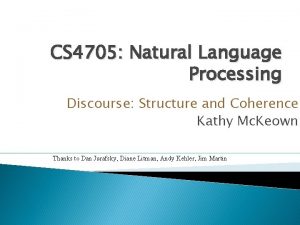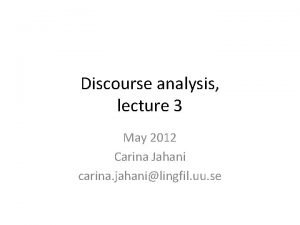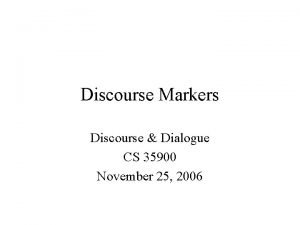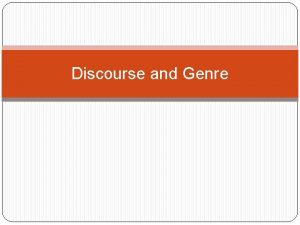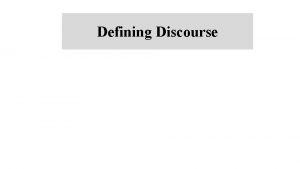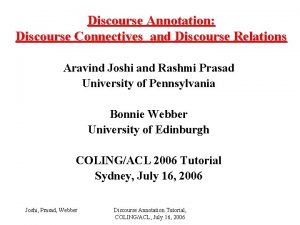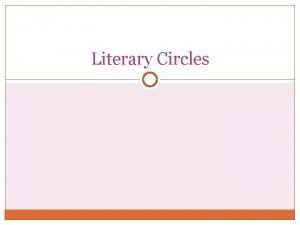Cohesion in Literary Discourse 1 Cohesion q Cohesion




























- Slides: 28

Cohesion in Literary Discourse 文学语篇中的衔接 1

Cohesion q. Cohesion: the grammatical and/or lexical relationship between different elements of a text. q. This may be the relationship between different sentences or between different parts of a sentence. q. Is Jenny coming to the party? q. Yes, she is. q. Jenny: she; is coming and is

Co-reference Syntactic devices Ellipsis cohesion Lexical Repetition Lexical devices Elegant Variaton

Cohesion Co-reference 指称 Syntactic Devices Ellipsis 省略

Co-reference q. Co-reference is the means of referring to something else in the text. q. A device for linking sentence with sentence and avoiding repetition

Cohesion Anaphoric 上指 Co-reference Cataphoric 下指

Co-reference q Anaphoric 上指: something that has already been mentioned in the text q Cataphoric 下指: something that is yet to come q Both are signalled by the third person pronouns (he, she, it, they, him, her, them) and the definite article (the)

Anaphoric 上指 q My uncle Melik was just about the worst farmer that ever lived. He was too imaginative and poetic for his own good. What he wanted was beauty.

Anaphoric 上指 q And ice, mask-high, came floating by… q The ice was here, the ice was there, q The ice was all around. q (Colerige, The Ancient Mariner )

Anaphoric 上指 q Tom Sponson, at fifty-three, was a thoroughly successful man. He had worked up a first-class business, married a charming wife, and build himself a good house in the London suburbs that was neither so modern as to be pretentious nor so conventional as to be dull. He had good taste.

Anaphoric 上指 q The items that have anaphoric reference constitute the given information and has the function of providing structural and semantic continuity.

cataphoric 下指 q They had grown up next door to each other, on the fringe of a city, near fields and woods and orchards, with sight of a lovely bell tower that belonged to a school for the blind. q Now they were twenty, had not seen each other for nearly a year. There had always been playful, comfortable warmth between them, but never any talk of love. q His name was Newt, Her name was Catherine…

Anaphoric上指 and cataphoric 下指 q I will wait for her in the yard that Maggie and I made so clean and wavy yesterday afternoon. A yard like this is more comfortable than most people know. It is not just a yard. It is like an extended living room.

cataphoric 下指 q Both are openings of short stories. The pronouns in the passages not only provide discourse cohesion, but also have the function of arousing the reader’s curiosity so that they may be immediately involved in reading the story. The great suspense is produced. Such use of cataphoric reference is characteristic of literary discourse.

Ellipsis 省略 q In literature, grammatical ellipsis means to is not make merely the a work compact and cohesive but also a rhetorical device to express certain aspects of the meaning or message of the work. The elliptical style is common in the representation of interior monologue.

Ellipsis 省略 q Quick through the window. Escape. I have a pistol; I’ll hold them back. Too late. Gestapo men under the windows aiming pistols into the room. Detectives have forced the door, rush into the room through the kitchen. One, two, three—nine of them. …

Ellipsis 省略 q The ellipsis here, rhetorically speaking, seems to be multi-functional. q Firstly, it can bring great immediacy to the scene being described, thus making it appear as if it was actually passing before the eyes. q Secondly, the brevity of the sentence structure create a sense of urgency and tension.

Ellipsis 省略 q Finally, the ellipsis also manifests the speaker’s wisdom, his quick succession of thoughts.

Lexical Repetition Lexical devices Elegant Variaton

Lexical repetition q Tom’s mischievous daring, ingenuity, and the sweet innocence of his affection for Bechy Thatcher are almost as sure to be studied in American schools today as is the Declaration of Independence. q Mark Twain’s own declaration of independence came from another character.

Elegant Variation q My uncle straightened up, breathing deeply. q Put the little creature down, he said. Let us not be cruel to the innocent creations of Almighty God. If it is not poison and grows no larger than a mouse and does not travel in great numbers and has no memory to speak of, let the timid little thing return to the earth. Let us be gentle toward these small things which live on the earth with us.

Speech acts, The Cooperative Principle and Turn-taking 言语行为,合作原则和话轮转换 22

Turn-taking q The speaker and the listener constantly change their roles, i. e. the speaker becomes the listener and the listener becomes the speaker. q In other words, the participants in a conversation take turns in speaking.

Turn-taking q She declared decisively, “We will not pay you ten thousand dollars. But we will pay you twenty-five thousand dollars. q The house detective’s eyes bulged. q “In return for that, ” she continued evenly, “You will drive our car north. ” q Ogilvie continued to stare. q “Twenty-five thousand dollars, ” she repeated.

Turn-taking q “Ten thousand now. Fifteen thousand more when you meet us in Chicago. ” q Still without speaking, the fat man licked his lips. His beady eyes, as if unbelieving, were focused upon her own. The silence hang. q Then, as she watched intently, he gave the slightest of nods. q The silence remained. At length Ogilvie spoke.

Turn-taking q “This cigar botherin’you, Duchess. ” q As she nodded, he put it out.

Turn-taking q Who has most turns? q Who has the least? q Who has the longest turns? q Who has the shortest? q Who initiates conversational exchanges? q Who responds? q Who controls the conversation topic? q Who follows the topic of others?

Turn-taking q Who interrupts? q Who is interrupted? q Who uses the turns of address not marked for respect? q Who use the turns of address marked for respect? q Who allocates turns to others?
 What is discourse analysis
What is discourse analysis Literary techniques
Literary techniques While wall streetjournal
While wall streetjournal Gender discourse analysis
Gender discourse analysis Discourse analysis topics
Discourse analysis topics Rhetorical patterns example
Rhetorical patterns example Discourse and text
Discourse and text It
It Pragmatic synonym
Pragmatic synonym What is formal links in discourse analysis
What is formal links in discourse analysis Discourse analysis and vocabulary
Discourse analysis and vocabulary Exposition rhetorical mode
Exposition rhetorical mode Textual aspects of lexical competence
Textual aspects of lexical competence Universal quantification examples
Universal quantification examples Free indirect discourse
Free indirect discourse Field of discourse
Field of discourse Discourse integration in nlp
Discourse integration in nlp Dct
Dct Direct speech exercise
Direct speech exercise What is discourse in nlp
What is discourse in nlp Discourse competence adalah
Discourse competence adalah Topic and the representation of discourse content
Topic and the representation of discourse content Foregrounding and backgrounding in discourse analysis
Foregrounding and backgrounding in discourse analysis Discourse markers
Discourse markers Concept of discourse
Concept of discourse What is genre
What is genre Language
Language Tamu cultural discourse
Tamu cultural discourse Social and discourse aspects of interlanguage
Social and discourse aspects of interlanguage


